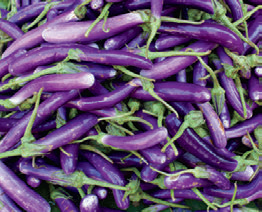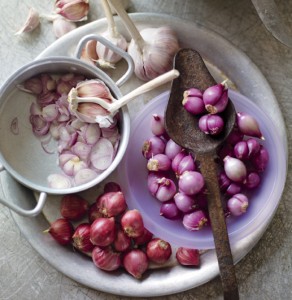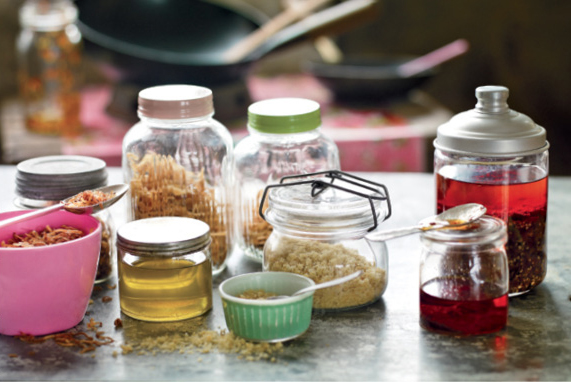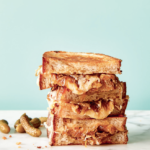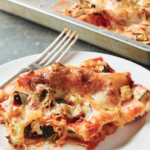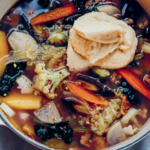Eggplants & Asian Shallots
Naomi Duguid on eggplants, from her new cookbook Burma: “In Southeast Asia, people grow and eat a wide variety of eggplants, from long green or pale violet or dark purple to round ones that may be white or white with pale green or bright yellow. All are varieties of Solanum melongena, a plant native to India that has been cultivated in Asia for millenia. Newcomers to the region find it hard to believe that eggplants can come in so many different guises. In North America, a wider variety of eggplants is now available, especially in Southeast Asian grocery stores. In general, the long Asian eggplants are less bitter than the large round purple Mediterranean varieties; they are never presalted to draw out bitterness.”
Here’s a recipe for an eggplant salad that’s a mainstay in her enviably rich arsenal.
Roasted Eggplant Salad
Serves 4
“Crunchy and a little hot from the fine slices of raw shallot, smooth textured from the eggplant, this salad has a nice balance of tart lime juice and aromatic shallot oil. It’s one of my favorites: I serve it with any and every kind of meal. It’s also a great dish for a potluck.”
- 1 pound long Asian eggplants (3 medium)
- 1/3 cup thinly sliced shallots, soaked in cold water for 10 minutes and drained
- 1 tablespoon Shallot Oil (recipe follows)
- 1 tablespoon fresh lime juice
- 2 teaspoons Fried Shallots (recipe follows), or to taste
- 1 teaspoon salt, or to taste
- About1/4 cup coarsely torn coriander, finely chopped mint, or Vietnamese coriander
Preheat the oven to 450°F or preheat a charcoal or gas grill to medium-hot.
Prick the eggplants all over with a fork and place on a baking sheet in the center of the oven, or place on the grill rack about 5 inches above the fire. Bake for about 30 minutes, or until brown and very softened. Or if grilling, turn the eggplants to expose all sides to the heat, until cooked through and very soft, about 20 minutes. Set aside to cool.
Once the eggplants are cool enough to handle, separate the flesh from the skin and stem: you can either cut the eggplants lengthwise in half and scrape out the flesh, or cut off the stems and then peel off the skin. Place the flesh in a bowl (you should have about 1½ cups). Mash with a fork, leaving it a little lumpy.
Add the sliced shallots, shallot oil, and lime juice, then mix thoroughly. Add the fried shallots, salt, and herbs and mix again. Taste and adjust seasoning before serving.
From left: Fried Shallots, Shallot Oil, Toasted Chickpea Flour, and two versions of Red Chile Oil—one strained and, behind it, one with the chile residue still in the oil</small
Fried Shallots and Shallot Oil
Makes a generous ¾ cup flavored oil and about 1¼ cups fried shallots
- 1 cup peanut oil
- 2 cups (about ½ pound) thinly sliced Asian or European shallots
Place a wide heavy skillet or a large stable wok over medium-high heat and add the oil. Toss in a slice of shallot. As the oil heats, it will rise to the surface, sizzling lightly. When it’s reached the surface, add the rest of the shallots, carefully, so you don’t splash yourself with the oil, and lower the heat to medium. (The shallots may seem crowded, but they’ll shrink as they cook.) Stir gently and frequently with a longhandled wooden spoon or a spider. The shallots will bubble as they give off their moisture. If they start to brown early, in the first 5 minutes, lower the heat a little more. After about 10 minutes, they should start to color. Continue to cook, stirring occasionally to prevent them from sticking to the pan or to each other, until they have turned a golden brown, another 3 minutes or so.
Line a plate with paper towels. Use tongs or a spider to lift a clump of fried shallots out of the oil, pausing for a moment to shake off excess oil into the pan, then place on the paper towel. Turn off the heat, transfer the remaining shallots to the plate, and blot gently with another paper towel. Separate any clumps and toss them a little, then let them air-dry for 5 to 10 minutes, so they crisp up and cool. (If your kitchen is very hot and humid, they may not crisp up; don’t worry, the flavor will still be there.)
Transfer the shallots to a clean, dry, widemouthed glass jar. Once they have cooled completely, seal tightly. Transfer the oil to another clean dry jar, using all but the very last of it, which will have some stray pieces of shallot debris. (You can set that oil aside for stir-frying.) Once the oil has cooled completely, cover tightly and store in a cool dark place.
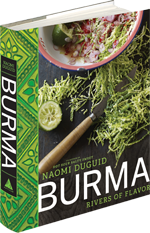 A writer, photographer, cook, and traveler who explores the world through the lens of food, Naomi Duguid is the author of Flatbreads and Flavors; HomeBaking; Seductions of Rice; Hot Sour Salty Sweet; Mangoes and Curry Leaves; and Beyond the Great Wall, all co-written with Jeffrey Alford. Keep up with the Naomi’s frequent travels by following her on her blog and website, on twitter (@naomiduguid), and on Facebook.
A writer, photographer, cook, and traveler who explores the world through the lens of food, Naomi Duguid is the author of Flatbreads and Flavors; HomeBaking; Seductions of Rice; Hot Sour Salty Sweet; Mangoes and Curry Leaves; and Beyond the Great Wall, all co-written with Jeffrey Alford. Keep up with the Naomi’s frequent travels by following her on her blog and website, on twitter (@naomiduguid), and on Facebook.
Learn more about Burma HERE. To sample more flavors from this cookbook, sign up for our newsletter and download a free copy of “The Curries and Noodles of Burma” HERE.
GET THE BOOK: Amazon | Apple | B&N | Kobo | Google | Sony

